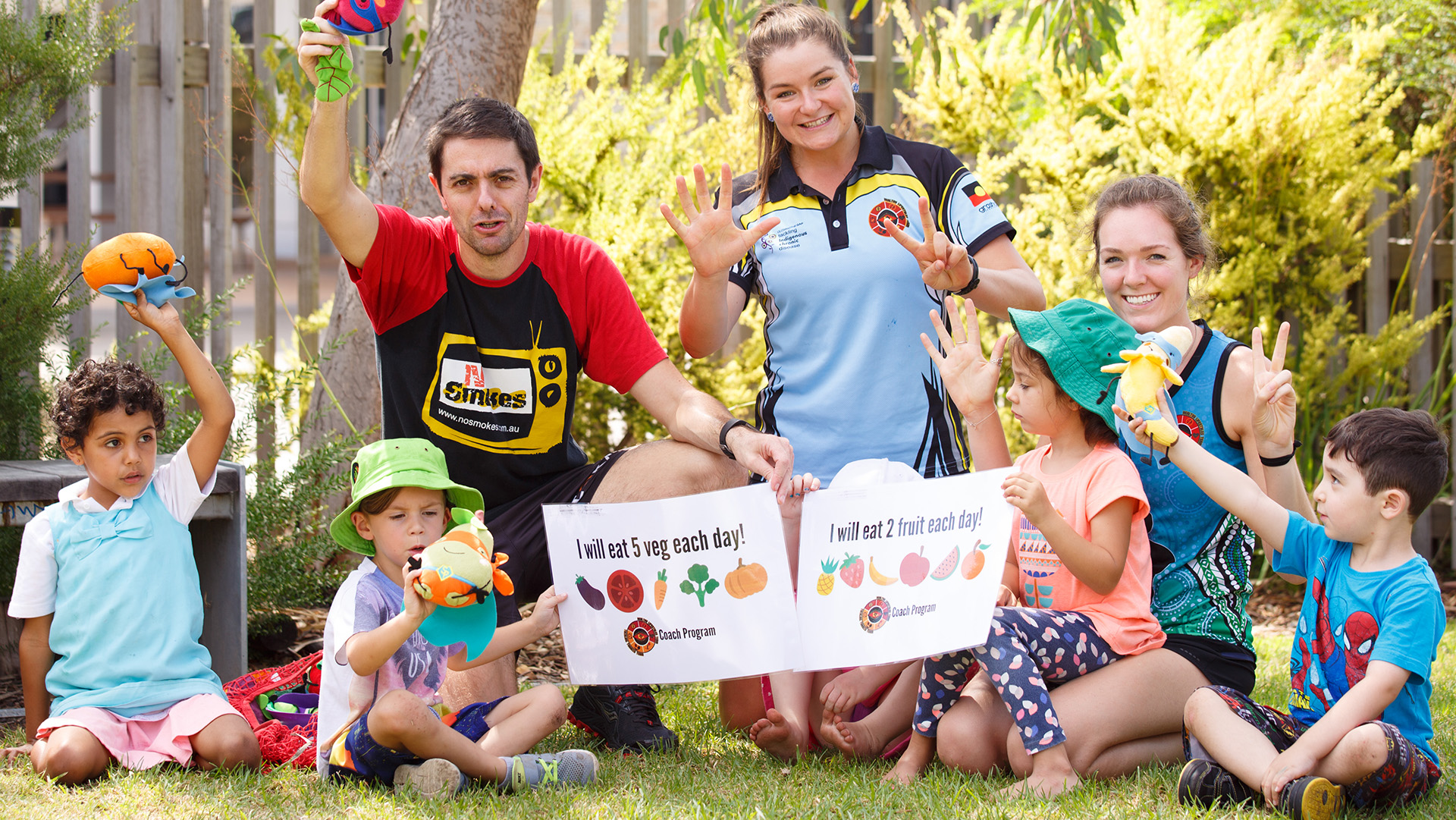-
One of the first steps to boosting health and wellbeing is having the knowledge to make positive choices around food, exercise, smoking and alcohol.
That’s why the Victorian Aboriginal Health Service’s Healthy Lifestyle Team created the Coach program, designed to help young Indigenous children learn about healthy lifestyle habits in a fun and engaging environment
The Community-controlled Victorian Aboriginal Health Service (VAHS) is based in Preston, in Melbourne’s north. The Coach program teaches three- and four-year-old Aboriginal children about nutrition through games and educational play. It gets the kids active, and promotes teamwork and cooperation at the same time as boosting knowledge around food choices.
The program has been running since 2013, and was awarded a 2016 Medibank Indigenous Grant to continue its inspiring work.
We asked the Healthy Lifestyle Team to share a little more about how the program is making a difference.
Tell us a bit about the background of the program?
The Coach program is a culturally relevant health promotion program that addresses high levels of obesity, inactivity, low vegetable and fruit consumption, and tobacco use in the Aboriginal Community.
The program is delivered in two separate Aboriginal early years settings on a weekly basis. The partnerships with the early years centres, Bubup Wilam for Early Learning and Yappera Childrens Services, are a vital element in the success of the program.
There is ample evidence showing that early child development programs have the potential to make a profound effect on future generations. We are putting this theory into practice by investing in three- and four-year old Koorie kids, their families and the broader community.
What happens during a Coach session?
All of our lessons revolve around healthy lifestyle behaviours including healthy eating, smoke free homes, being active, drinking water, cleaning teeth and connection to the Aboriginal Community.
We introduce the topic and have a short yarn with the children about why each message is important and relevant to them. A fun warm-up kicks off the session before introducing the day’s activities or games, which are physically active, fun and often involve props. We aim to personalise teaching, be healthy lifestyle role models and build relationships.
“All of our lessons revolve around healthy lifestyle behaviours including healthy eating, being active, drinking water and connection to Aboriginal culture and community.”
What have been some of the outcomes of the project so far?
We have received valuable feedback from both parents and teachers. Many parents have stories of children asking parents to quit smoking, telling them how many sugars are in their Coke or relaying other health messages. Teachers have incorporated Coach lessons into their curriculum and continue to see children playing the games we’ve taught them after we’ve gone.
How have the kids responded?
The kids look forward to Coach each week and successfully retain and internalise Coach messages. The four-year-olds who are in their second year of Coach consistently have a strong memory and understanding of our healthy lifestyle messages.
Out in the Community, it’s our connection with the children that allows us to be able to engage with their parents and older siblings around healthy lifestyles and tobacco cessation.
“We aim to personalise teaching, be healthy lifestyle role models and build relationships.”
How does the program contribute to closing the health gap between Indigenous and non-Indigenous Australians?
Lifestyle and chronic diseases are prevalent in the Indigenous community but are largely preventable. We believe one of the biggest issues in Indigenous health revolves around the lack of education in early childhood and adolescence, resulting in poor lifestyle habits and high risk of chronic disease.
Community wide shifts towards healthy lifestyle habits are necessary to close the gap, starting with each individual. We also need to acknowledge community champions and work together to create health-promoting community settings.
This requires multi-sectoral coordination, respectful partnerships such as this one with Medibank, and action in conjunction with consistent community engagement that spans all age-groups and socioeconomic strata.
What other services does VAHS provide?
VAHS has been providing holistic care to the Aboriginal Community for over 40 years, delivering a range of medical, dental and social services and promoting wellness and health.
Fundamental to the services provided by VAHS is the concept of Aboriginal health. When talking about Aboriginal health, we refer to the social, emotional and cultural wellbeing of the whole Community.
Within this is each individual achieving their full potential as member of the Aboriginal Community to which they belong. This means that the services we provide don’t just focus on the physical wellbeing of an individual, but many aspects of life.
Find out more about the Victorian Aboriginal Health Service.
Growing young Koorie health ambassadors

-
Mental fitness explained
Just as you work to strengthen your body, your mental health deserves attention and exercise too.
-
Signs it's time to visit the dentist
Nobody wants to go. But there are good reasons to – promise.
-
The link between stress, anxiety and jaw pain
Physiotherapist Michael Chan explains how stress and anxiety can cause jaw pain, and how to help get some relief.
-
When you can't sleep next to your partner
You love everything about them – except their sleep habits.
-
The 7 best sleep apps
7 apps for deep restorative sleep
-
5 ways to relieve stress
Discover 5 easy stress-relief techniques to calm your mind and body. Try exercise, breathing, outdoor time, positive self-talk, and more for a balanced life.
Subscribe to receive the best from Live Better every week. Healthy recipes, exercise tips and activities, offers and promotions – everything to help you eat, move and feel better.
By clicking sign up I understand and agree to Medibank's privacy policy



.jpg)


